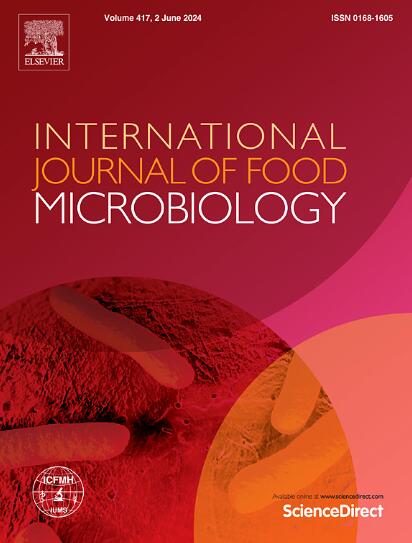自诱导剂2活性对发酵香肠品质特性和细菌群落的影响
IF 5.2
1区 农林科学
Q1 FOOD SCIENCE & TECHNOLOGY
International journal of food microbiology
Pub Date : 2025-05-26
DOI:10.1016/j.ijfoodmicro.2025.111285
引用次数: 0
摘要
发酵香肠的质量受到微生物代谢的显著影响,其中群体感应起着至关重要的调节作用。本试验研究了外源自诱导剂-2 (AI-2)活性对发酵乳酸杆菌332功能特性和发酵香肠品质的影响。结果表明,添加浓度为100 μmol/L的AI-2增强了发酵乳杆菌332清除羟基自由基和抗脂质过氧化的能力,降低了AI-2的活性,提高了亚硝酸盐的降解率。AI-2活性的升高增强了香肠的质地,降低了水分活性,增加了香肠的亮度(L值),而AI-2活性的降低促进了乳酸杆菌和乳酸杆菌的富集,激活了与碳水化合物、脂质和氨基酸代谢相关的代谢途径。这导致主要挥发性风味化合物的水平增加,包括己酸乙酯、乙酸芳樟和油酸乙酯。这些发现强调了AI-2在调节乳酸菌代谢中的关键作用,为改善发酵香肠的质量和感官特性提供了见解。本文章由计算机程序翻译,如有差异,请以英文原文为准。
Impact of autoinducer-2 activity on quality characteristics and bacterial community of fermented sausage
The quality of fermented sausages is significantly influenced by microbial metabolism, with quorum sensing serving a crucial regulatory role. This study investigated the impact of exogenous autoinducer-2 (AI-2) activity on the functional properties of Limosilactobacillus fermentum 332 and the quality of fermented sausages. The results showed that adding AI-2 at concentrations up to 100 μmol/L enhanced the hydroxyl radical scavenging and anti-lipid peroxidation abilities of L. fermentum 332, while decreasing AI-2 activity increased the nitrite degradation rate. Elevated AI-2 activity enhanced sausage texture, reduced water activity, and increased lightness (L⁎ values), whereas reduced AI-2 activity promoted the enrichment of Limosilactobacillus and Lactiplantibacillus, activating metabolic pathways related to carbohydrate, lipid, and amino acid metabolism. This resulted in increased levels of key volatile flavor compounds, including ethyl hexanoate, linalyl acetate, and ethyl oleate. These findings underscore AI-2's critical role in regulating lactic acid bacteria metabolism, providing insights into improving the quality and sensory characteristics of fermented sausages.
求助全文
通过发布文献求助,成功后即可免费获取论文全文。
去求助
来源期刊
CiteScore
10.40
自引率
5.60%
发文量
322
审稿时长
65 days
期刊介绍:
The International Journal of Food Microbiology publishes papers dealing with all aspects of food microbiology. Articles must present information that is novel, has high impact and interest, and is of high scientific quality. They should provide scientific or technological advancement in the specific field of interest of the journal and enhance its strong international reputation. Preliminary or confirmatory results as well as contributions not strictly related to food microbiology will not be considered for publication.

 求助内容:
求助内容: 应助结果提醒方式:
应助结果提醒方式:


